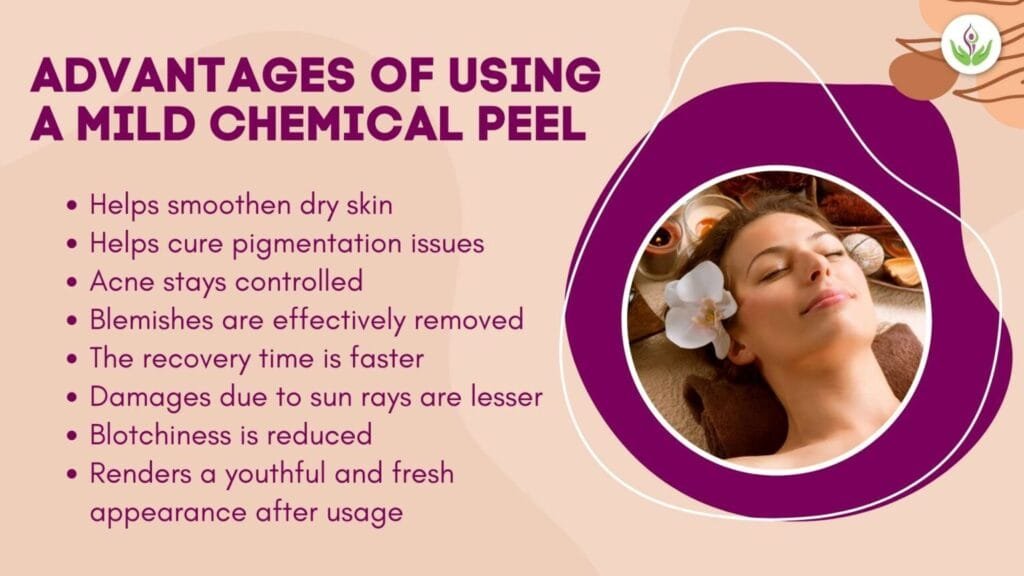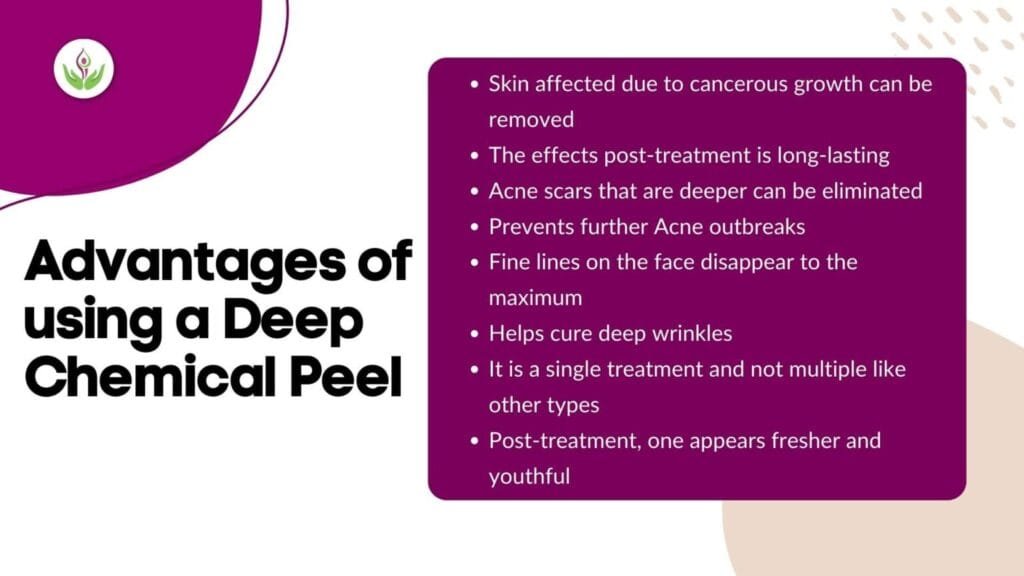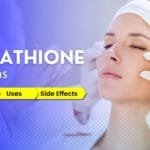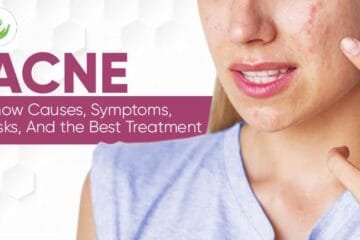Are you planning to go for chemical peels but are skeptical about them? It is better to understand a procedure completely before you decide on it. Chemical peels are a common procedure that many individuals with skin issues undergo these days. Read on as we discuss the procedure and the nitty-gritty around it to help you decide if and when you should be going for the procedure and what you should expect during and after it.
What are Chemical Peels?
It is a common occurrence for people to have skin issues. Such skin problems are bound to happen on the face too. A good dermatologist would suggest a chemical peeling treatment. A chemical peel is a medical procedure that can cure facial acne scars. Apart from that, the dermatologist would recommend the following:
- Chemical peel for Acne: If you have acne-prone skin, a chemical peel for acne can help you get rid of the issue and the acne scars. Chemical peeling for acne scars is a commonly sought-after procedure.
- Chemical peel for dark circles around your eyes. After the chemical peel for dark circles, you will experience visually lighter skin around the eyes.
- Chemical peel for pores on your face to open up
- Chemical peel for pigmentation of your facial skin. You can see visually clear and even-toned skin after undergoing a chemical peel for pigmentation. A chemical peel for skin whitening or a chemical peel for dark spots can also be carried out.
- Chemical peel for melasma, which is a skin disorder. Chemical peels for melasma have given positive results for many individuals at present.
- Chemical peels for lips that have lost color or have become dark can also be opted for.
So, what does the chemical procedure exactly involve? It is a simple process through which a chemical solution removes the top layers of the skin. In other words, one can call it a skin-resurfacing process. Generally, the chemical peels used are:
- Chemexfoliation
- Derma Peeling
The procedure aims to remove all the old skin to reveal new skin, which is youthful underneath.
Chemical peels are popular and the best way to remove skin imperfections. Thus, to start with, chemical peels for skin whitening can go up to improving fine lines and circles. One of the three methods below removes such skin, creating trauma or disruption.
The dermatologist would assist you in choosing one of these three procedures. The preferred procedure depends on your skin condition.
- Light chemical peel: The procedure warrants a chemical peel for two to five weeks
- Medium chemical peel: It does need many procedures
- Deep Chemical peel: minimum chemical peeling procedures, and sometimes even one would do
All these procedures have the same goal of giving clear and rejuvenated skin.
The goal is to remove the skin’s outer layer, known as the epidermis, and reveal new skin. All three procedures differ in the time taken and the number of times you must undergo them.
Combining a chemical peel with a few other cosmetic procedures is possible. The results are evident as one can feel their skin smoother. Youth does reset as the layers of skin at the top peel off after chemical peel procedures. You can make use of chemical peels for dark spots to treat them.
A wrinkle-free face does tend to make a person youthful to look at, and life is brighter.
Short Summary
A chemical peel is one of the best-suited procedures for skin- resurfacing. It does not involve any side effects, and the results are fast. There are three options for chemical peel facials. Your dermatologist will decide which is best for you.
What are the types of chemical peels?

There are 12 common types of chemical peels that people choose, and dermatologists advise them. They are as follows:
1. Glycolic chemical peel
The glycolic chemical peel is considered one of the best chemical peel procedures. The reason is simple: the acid has small molecular structures that allow deep penetration into the skin. Such penetration dissolves faster and removes dead skin easily. The chemical peel can be strong or light. It depends on the intensity of the treatment required. The advantages of using glycolic chemical peels are:
- Aging skin gets its glow back
- It removes dead skin
- New skin pores
- Skin surface smoothened
If you are looking for a solution to the above conditions you can go for the glycolic chemical peel.
2. Beta Peel:
Beta Peel deals with the removal of Acne. It is made up of Salicylic acid, which promotes exfoliation. It also exercises control over oily skin. Apart from this, it attacks the root cause of Acne, bacteria, and reduces acne breakouts.
3. Vitalize Peel:
The Vitalize Peel is the best type to start with if one is not used to chemical peels. Vitalize Peel involves little peeling, but the advantages are manifold. It makes your skin pigmentation lighter, and one can feel changes overall. The acid is a combination of:
- Salicylic acid
- Citric acid
- Retinol
- Lactic acid
4. Pigment Balancing Peel:
Similar to Vitalize Peel, a combination of acids works together to achieve perfect pigmentation. It even cleanses brown spots, but it takes many applications to do so. It is advisable to use sunscreen for better results.
5. Retinol Peel:
Retinol is otherwise called “Vitamin A” and is commonly used in various skin care products. Like glycolic acid, it is molecular in size and can easily penetrate the skin. The advantages of using Retinol and its deep penetration are:
- Complexion rejuvenated
- It hydrates the skin
- Acne breakouts minimized
- Pores opened up like never before
- Accelerates skin growth
6. Lactic Peel:
Lactic Peel is a specialist in dealing with sensitive skin. The lactic peel is made of milk and is gentle on the skin while keeping it moisturized.
7. Mandelic Peel:
Mandelic acids are quite popular in the world of anti-aging skin products, and there is a specific reason for that. It speeds up cell turnover by effectively dissolving the bonds that bind the skin cells. Here are the advantages of using Mandelic acid:
- Effective in removing dead skin
- Accelerates the growth of Collagen
- Such acceleration leads to the thinning of an external layer called Stratum Cornering
- The thinning of this layer allows light to enter, leading to youthful skin
- Skin texture is at its best
- It lightens wrinkles and fine lines considerably
Mandelic peel is another very common kind of peeling procedure opted for at present.
8. Jessner’s Peel:
Jessner’s peel is an age-old remedy that uses an acidic liquid. The acid successfully eradicates dead skin on top and promotes youthful skin growth. Jessner’s Peel can:
- Prevents scar from appearing
- Skin tone is evenly spread
- Dark patches’ appearance decelerated
- Age spots minimized
- Smoothes wrinkles
- Smoothes fine lines
- Treats skin discoloration or Melasma
- Treats acne scars
If you are looking for the above benefits, Jessner’s peels can be a good option for you.
9. Vitamin C Peel:
The vitamin C Peel effectively prevents harm caused by free radicals such as pollution, sun rays, etc. It is also a good bleaching agent.
10. Alpha jewel peel
Alpha jewel peels are ‘on the go’ summer peels and require minimum downtime. It clears dead skin at the surface level.
11. TCA Peel:
TCA is an acronym for trichloroacetic acid peel. It contains an acid by the same name and treats
- Acne scars
- UV rays discoloration
- Hyperpigmentation
- Wrinkles etc.
12. VI Peel
The VI Peel is largely used to contain the aging of the skin. It requires minimum downtime and can be used in the chest and back apart from the face.
Types of chemical peels Hyperpigmentation
Hyperpigmentation is one of the most commonly occurring skin issues. The appearance of dark patches on the skin compared to the rest signifies Hyperpigmentation. The various types of hyperpigmentation are:
- Melasma
- Sunspot
- Post-inflammatory Hyperpigmentation
- Types of chemical peels for Acne
Types of chemical peels for acne
There are three types of chemical peels for Acne. They are:
- Superficial Peel
- Medium Peel
- Deep Peel
Types of chemical peels for the face
Chemical peels for the face are four. They are:
- AHA peels
- BHA peels
- TCA peels
- Phenol peels
Short Summary
As seen above, there are various types of chemical peels for many different skin issues. The chemical may change to cure the problem, but the treatment mode is the same. Also, the periods vary from one another.
What is the most popular chemical Peel in India?
Everyone likes instant results, and chemical peels fit into that category. They are generally quite fast in their results. There are choices for the best chemical peel for sagging skin, too. The Indians also have more to choose from when it comes to the best chemical peel at home than a couple of years ago.
Here are the three best kinds of chemical peels in India:
1. Plum Exfoliating Peel with Green Tea
Main contents:
- 10% AHA (Glycolic Acid),
- 0.5% BHA, and
- 5% PHA
Advantages:
- Does not create an extra sensation on the face
- A viable alternative in comparison to other kinds of chemical peels
- It brings down dullness on the face
- Reduces dryness on the skin
- It adds a natural shine to the skin
2. Dr. Sheth’s Medium Strength Peel
There are various skin issues, and there is a solution from Dr. Sheth’s medium Strength Peel. They offer top professional chemical peel brands
- Lactic Acid Peel
- Mandelic acid peel (For beginners)
- Medifacial Peel (super-strong)
- Medium-strength peel (most popular for oily skin and skin types that are more susceptible to acne)
Contents:
- Aloe
- Centella extracts
- 2% Salicylic acid
- 5% Glycolic acid
- 5% Mandelic acid
- 5% Lactic Acid
Advantages:
- Creates no extra sensation on the skin
- Brings down oiliness
- Increases rich texture
- Prevents skin from drying out
3. Deconstruct Exfoliating Serum:
The serum comes in two forms. One is mild, and the other is strong. Both are wash-off- peels. It is a mix of Glycolic, Lactic, Tartaric, and Malic Acid. The advantages are:
- Removes congestion
- Enhanced glow
- No extra sensation or tingle
Which chemical Peel is most effective?
The deep peel, otherwise known as TCA, is considered the most effective chemical peel.
What is a Level 3 chemical peel?
Level 3, otherwise known as TCA, has more medical strength but has to be kept for three to five days for best results.
What kind of chemical peels do dermatologists use?
Glycolic acid peels are the chemical peels that dermatologists generally use because they are alpha-hydroxy.
Which chemical peel is best for beginners?
Lactic acid is the best chemical peel for beginners for the following reasons:
- It gets rid of minor wrinkles
- Enhanced glow
- Gentle on the skin
- Smoothes skin
Short Summary
India is just a little behind in using chemical peels, and the growth has increased in the past two years. There are various professional chemical peels depending on your requirements. You can use products that are the strongest at-home chemical peels by following the instructions.
How is chemical peeling done?
Chemical peeling is a simple and mostly risk-free procedure. However, a few steps must be followed for the best results. The steps for chemical peeling are listed below.
Before the Chemical Peeling Procedure
A chemical peeling procedure is typically done in an outpatient surgical facility or an office. Before the process, the doctor will protect your hair and thoroughly clean your face. They would also cover your eyes with the help of goggles, gauze, ointment, or gauze.
Typically, pain relief is not required for a light chemical peeling process. If you are undergoing a medium chemical peel, the doctor can give you a painkiller or a sedative. For a deep chemical peel, the doctor might give you a sedative or something similar to numb your body area under treatment.
During the procedure,
A light chemical peel is also known as a superficial chemical peel. It removes the outermost layer (epidermis) of the skin. A light chemical peel is usually required to treat acne, fine wrinkles, irregular skin tone, and dryness. A light chemical peel can be done once every 2 to 5 weeks.
Steps:
- The doctor will apply a chemical solution to your face using a brush, gauze, a cotton ball, or a sponge. The chemical solution is typically something that contains salicylic acid or glycolic acid. With the application, the skin will begin to turn white.
- While the chemical solution is on your face, you will feel a mild sting on the skin.
- The doctor will now apply a neutralizing solution to remove or wash the chemical solution from the area under treatment.
After a Light Chemical Peel
The treated skin will be dry and red and experience mild irritation. All of these outcomes will become less apparent with every repeated process. The doctor may apply protective ointments, like petroleum jelly, to comfort the skin. If you wish to put on makeup, you can do it the next day of the procedure.
After a light chemical peel, the treated skin areas might take up to seven days to recover. The newly growing skin might be slightly lighter or dimmer than the normal one.
During a Medium Chemical Peel
A medium chemical peel removes the epidermal skin cells and the upper portions of the dermal layer (the middle layer of the skin). It treats uneven skin tone, acne scars, and wrinkles. However, to achieve the desired results or to maintain them, you might have to undergo the procedure repeatedly.
Steps:
- The doctor will use gauze or a cotton-tipped applicator to apply a chemical solution. The chemical solution generally contains trichloroacetic acid. However, trichloroacetic acid is sometimes combined with glycolic acid. The skin under treatment will begin to whiten.
- After a while (a few minutes), the doctor will apply a cool compress to the treated skin. This is done to cool down your skin. The doctor can also offer you a hand-held fan to cool your skin. At this stage, no neutralizing solution is required. However, you might feel a burning and stinging sensation for about 20 minutes.
After a Medium Chemical Peel
After treatment, the skin will be swollen and red. You will experience stinging. To prevent dryness or soothe the treated area, the doctor might apply a protective ointment such as petroleum jelly. After 5 to 7 days of treatment, you can use makeup to conceal any redness.
Use packs of ice as comforters. The doctor might give you some over-the-counter pain relief medicines like ibuprofen (Advil, Motrin IB, etc.), and Naproxen sodium (Aleve, etc.), to eliminate discomfort.
Schedule and visit the doctor soon after your treatment so that they can monitor the healing. As the swelling reduces, the treated skin will start forming a crust over itself. The crust might develop a darker tone or brown blotches. A medium peel can take about 14 days to heal. However, the redness might last for several months.
During a Deep Chemical Peel
Deep chemical peeling removes the skin cells more profoundly than light and medium peels. It is done to treat deep wrinkles, precancerous growths, or scars. You need not repeat the procedure with a deep chemical peel to achieve a full effect.
Steps
- The heart rate is closely monitored, and the patient is continuously given intravenous (IV) fluids.
- The doctor would use a soft cotton-made applicator to apply the phenol or carbolic acid to your skin. Once done, the treated skin will start turning gray or white.
- The doctor will perform the procedure in parts, taking 15-minute intervals to limit your skin exposure to phenol. The complete facial process can take about 90 minutes.
After a Deep Chemical Peel
After a deep chemical peel, you will experience swelling and redness. Swelling might cause your eyelids to shut, and there might be throbbing and burning sensations. The doctor will use a surgical dressing to dress the treated skin. The doctor might even need to prescribe painkillers.
You will be required to soak the treated area, apply ointment multiple times a day, and continue the process for about 15 days. The treated portion will develop new skin nearly two weeks after undergoing a deep chemical peel, even though the redness may last several months. The treated skin can become lighter or darker than normal skin. The treated skin might also lose its tanning ability.
While you are healing, you might prefer staying home. You also need to schedule several follow-ups with your doctor so that they can closely monitor your healing process. Once the treated skin completely recovers in a couple of weeks, you can restart using makeup to cover the redness. Also, use sunscreen regularly.
How many layers of skin does a chemical peel remove?
There are two layers to the skin. One is called the epidermis, and the other is the dermis. The epidermis is on top of the dermis, and both of these layers are affected by the chemical peel procedure, even though it is controlled removal.
What does the face look like after a chemical peel?
The treated part of your face is bound to look swollen, along with redness, after a medium chemical peel. The dermatologist would apply petroleum jelly to reduce the dryness. It would take five to seven days for the face to start becoming normal, and cosmetics can easily cover redness.
At what age should you start chemical peels?
It is best to start using chemical peels when you are twenty years old.
How do you prepare for a chemical peel?
There are four golden rules to prepare your skin before using a chemical peel for the best results. They are:
- Stay away from exfoliating at least a week before the peeling
- Avoid wearing makeup
- The sun’s UV rays are harmful. Avoid the sun
- Drink water regularly and stay hydrated
Short Summary
One must prepare well to achieve the best results after using chemical peels. Some rules start as early as a week before the scheduled date. On the other hand, one has to meticulously follow instructions on how to apply the chemical peel. More important is to avoid using the one which causes a burning sensation. Finally, you should know when to peel them off.
What are the Chemical peeling advantages and disadvantages?
There are various advantages of using a chemical peel. Chemical peels are of three types, and the advantages are listed separately below.

Advantages of using a Mild Chemical Peel:
Some of the advantages of mild chemical peels are as follows:
- Helps smooth dry skin
- It helps cure pigmentation issues
- Acne stays controlled
- Blemishes are effectively removed
- The recovery time is faster
- Damages due to sun rays are lesser
- Blotchiness is reduced
- Renders a youthful and fresh appearance after usage
Advantages of using a Medium-Depth Chemical Peel:

Some of the advantages of medium-depth chemical peels are as follows:
- The disappearance of facial lines, even though not completely
- Birthmarks on the face stand reduced
- Vast improvement in pigmentation of the skin
- Dry skin is reduced
- Permanent Acne scarring is reduced
- Recovery of skin damage due to the sun’s rays
- Blotchy skin receives an uplift
- The result of chemical peeling is a youthful appearance
Advantages of using a Deep Chemical Peel

Some of the advantages of deep chemical peels are as follows:
- Skin affected by cancerous growth can be removed
- The effects post-treatment are long-lasting
- Acne scars that are deeper can be eliminated
- Prevents further Acne outbreaks
- Fine lines on the face disappear to the maximum
- It helps cure deep wrinkles
- It is a single treatment and not multiple, like other types
- Post-treatment, one appears fresher and youthful
Disadvantages of chemical peeling on the face
Even though the advantages outweigh the disadvantages, one must be cautious of the following:
- Medium-depth and Deep Peel are prone to excessive peeling
- The first application of a chemical peel does sting a person. It is unavoidable
- Deep and medium peels do cause redness. However, it is milder with the light peel, which feels like a sunburn only.
- Numbness would exist, even though it was temporary.
- Deep chemical peel treatments result in the removal of many dead skin cells. The person can feel the removal process for a temporary period.
- It is advisable to stay off the glare of the sun- rays. The rays would make your skin more sensitive.
- Nothing comes without a cost, and chemical peel treatment is also unaffordable to many people.
The person who has undergone the treatment should know the risks post-treatment. The dermatologist imposes many conditions that, when exceeded, would spoil the very purpose. Exposure to Sunlight, for example, is a deterrent. Therefore, one has to obey all the rules for the best results. The results are amazing as one turns back the years and looks youthful.
Is chemical peeling harmful to the skin?
Chemical peeling does not worsen your skin. It makes it better. Results are based on how the procedure is implemented.
Can chemical peels burn your face?
Chemical peels do not burn your face in a practical sense. It creates a burning sensation and throbbing; one can feel these effects up to two weeks post-treatment. Redness does persist for months. The burning sensation tends to affect your eyelids, which you can force shut.
Does skin get darker after a chemical peel?
The skin’s darkness depends on the three chemical peels used (Light, Medium, or Depth). One should know it is a temporary phenomenon only. The darkness also does not have an immediate effect. It is caused by the crust and shreds caused by redness. The redness levels, in turn, result from the type of chemical peels used. The light type causes minimum redness and fewer dark spots, whereas the medium and deep peels develop more redness, which leads to darker spots comparatively. Thus, chemical peel side effects do exist but are temporary.
How many times can a chemical peel be done?
Having a chemical peel done too often would result in overexposure to exfoliants. Such exposure leads to inflammation, redness of the skin, and, ultimately, skin damage, and these effects are due to the chemical peel gone wrong.
Therefore, the solution lies in receiving a chemical peel treatment only after the earlier one has dried out. In the case of the light type, one can afford to do it once a month. In the case of deep peels, one has to wait for two to three years. Thus, the frequency depends on the healing time of the previous treatment.
Short Summary
There are many advantages to undergoing a chemical peel treatment. The results are purely dependent on the right type of chemical peel chosen. The disadvantages are that only an increase of precautions is not taken, and even dark spots are temporary. The frequency of chemical peel varies from person to person as it is subject to the healing of the previous one.
What kind of results can be expected after a chemical peel?
It is not wrong to fear the results post-medical treatment. Chemical peels are no exception. The fact remains that if the perfect procedure is followed, such fears would not exist. However, here are ten things you can expect after your chemical peel treatment with timelines.
- The initial few hours – Redness followed by tingling or burning of the skin
- The First day – Skin goes dry, and irritation follows. A mild swelling develops
- Second and third day: Flaky skin along with discoloration becomes noticeable
- Day 4 – Tanned skin is evident, and skin appears darker
- Day 5 to Day 7- All side effects mentioned above tend to disappear, and normal skin resurfaces with more glow and youthfulness
Up until the second week, new skin growth continues, but darkness or discoloration will last for a month.
How long does it take for a chemical peel to show results?
It would take two weeks at the maximum for results to be seen after the chemical peel. The redness would, however, persist.
How long do chemical peel results last?
The results vary depending on the type of chemical peel used. The common timespan for results to last is as follows:
- Light type can last up to one or two months
- A medium peel can last a minimum of two months and a maximum of six months
- Deep peels last at least two years but generally a lifetime
Is a chemical peel worth it?
Chemical peels deliver results faster than one expects. The side effects do not exist if the treatment follows instructions. Skin texture, youthfulness, and a brighter outlook are irreplaceable. Hence, it is worth it.
Are chemical peels safe?
Chemical peels are safe, provided the procedure and instructions are followed perfectly. It can improve your skin texture but can also contribute to infections. Deep peels are to be administered carefully, as side effects are more in this treatment.
Chemical peel before and after Results
Before a chemical peel, one should prep their skin by using these for three weeks before the treatment:
- Serums that hydrate
- Products with glycolic acid
- Apply sunscreens
- Use moisturizers
- Use retinoids or products that have bleaching agents
Avoid the following one week before the chemical peel:
- Waxing
- Threading
- Epilating
- Depilation
- Lasers that reduce hair
- Exfoliation
- Dying your hair
- Scrubbing
These tips seem trivial but are essential to follow if you desire the best results.
Short Summary
People who undergo chemical peels would indeed be anxious for fast results. The treatment does yield fast results, but for best results, follow the prep before and after the peel. Due to their safety, chemical peels are worth it.
How much does a chemical peel cost in India?
Chemical peels are prevalent in India as well as abroad. However, the costs are different as they depend on the following factors:
- The type of peel your doctor could recommend A light or medium peel is bound to cost less compared to a deep peel.
- The doctor would decide on the strength of the treatment, apart from the type. On the other hand, the number of sessions may increase. The cost is thus pushed up.
- The clinic you choose to get your chemical peel done, along with the doctor’s reputation, is another factor in pushing the cost upwards.
Taking all these into account, along with the geographical area, determines the cost. It would be costlier in metropolitan areas and cheaper in smaller cities.
The cost would vary between Rs.1500 to Rs. 10,000 for every session. The cost is an average cost.
Costs differ based on the strength of the peel.
- The light chemical peel may cost between Rs.1500 & Rs. 5000/-
- The medium Strength type is expected to cost between Rs.3000 & Rs.7000/-
- The Deep strength type would involve an expense of Rs. 5000 to Rs. 9000/-
The price of the chemical peel would increase with the demand. The cost is increasing daily, but on the other hand, one can apply chemical peels from the confines of their home, making it more economical. So, what are the risks involved in this procedure?
Firstly, you have to be in consultation with a dermatologist who should be both qualified and experienced. Secondly, you should be diagnosed properly and informed of which type of treatment you qualify for. The choice, of course, lies between, Superficial, Medium, and Depth. Thirdly, the cost has to be ascertained after the type and number of sessions are decided. One should remember that insurance is not available for such cosmetic procedures.
Conclusion
Chemical peels are gaining in popularity daily in today’s world, including India. The procedure is easy, and the results are quicker and more satisfactory. Almost everyone who is twenty years of age qualifies for the procedure. There are do’s and don’ts naturally. If one follows the instructions perfectly, there are no side- effects. All side effects are common knowledge and temporary.














